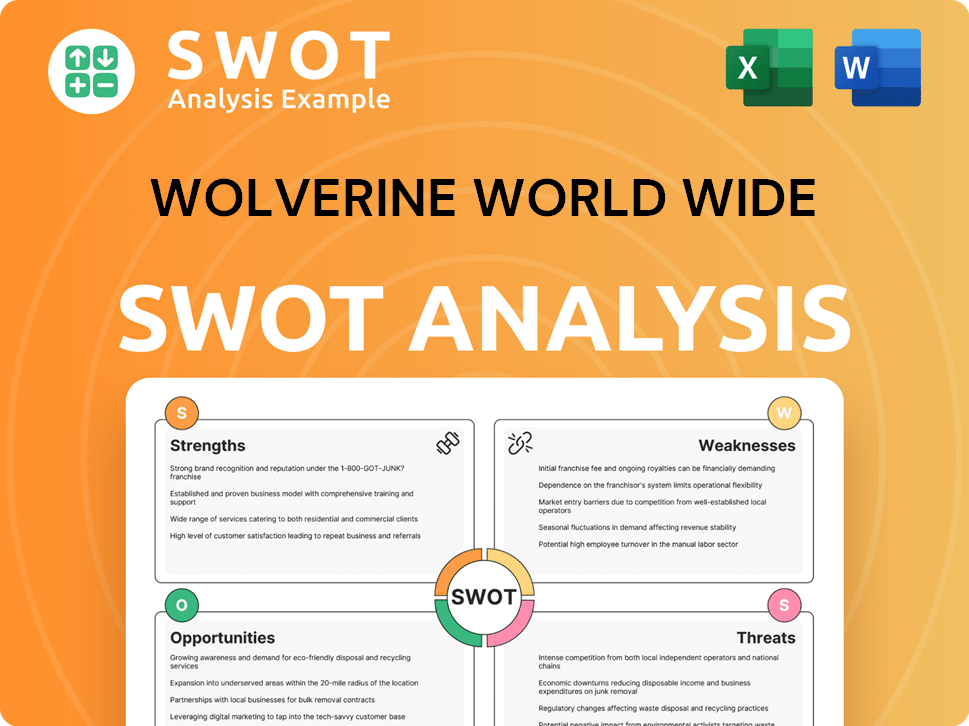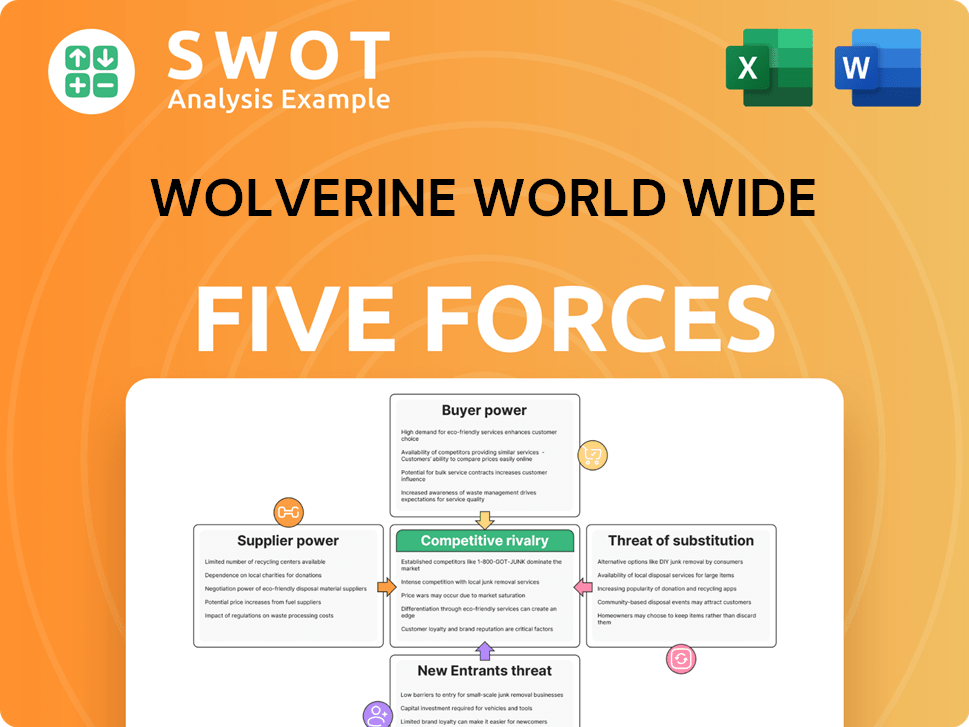Wolverine World Wide Bundle
How Did a Michigan Tannery Become a Global Footwear Giant?
Journey back in time to uncover the captivating Wolverine World Wide SWOT Analysis and its remarkable transformation. From its humble beginnings in 1883 as a small tannery, the Wolverine Company has evolved into a global force in the footwear industry. Discover how innovation and strategic acquisitions propelled this Michigan company to the forefront of the market.

This exploration into Wolverine Company History reveals a story of resilience and adaptation. The WWW company's expansion, marked by iconic Wolverine brand acquisitions and product diversification, showcases its ability to navigate the ever-changing landscape of the footwear industry. Learn about the key milestones that shaped Wolverine World Wide's trajectory, from its early focus on durable work boots to its diverse portfolio of brands catering to a wide range of consumers.
What is the Wolverine World Wide Founding Story?
The Owners & Shareholders of Wolverine World Wide trace back to 1883, in Rockford, Michigan. The company, initially known as the Hirth-Krause Company, was established by G.A. Krause and Fred Hirth. This marked the beginning of what would become a significant player in the footwear industry.
The primary focus of the Hirth-Krause Company was the production of high-quality leather. This leather was specifically intended for durable work boots. These boots were essential for the expanding industrial workforce of the time.
The company's initial funding likely came from personal capital and local investments. Early product development included experimenting with horsehide for footwear. This innovative approach helped set them apart in the nascent footwear industry.
The Wolverine Company History began in 1883 as the Hirth-Krause Company in Rockford, Michigan.
- G.A. Krause, a tanner, and Fred Hirth founded the company.
- The initial focus was on producing leather for work boots.
- Early funding came from personal capital and local investments.
- They were among the first to use horsehide for footwear.
The company's name changed to Wolverine Shoe and Tanning Corporation in 1901. Later, in 1966, it became Wolverine World Wide, Inc. These changes reflected its expanding scope and global aspirations. The late 19th-century context, marked by industrial growth, significantly influenced the company's creation and early success.
Wolverine World Wide SWOT Analysis
- Complete SWOT Breakdown
- Fully Customizable
- Editable in Excel & Word
- Professional Formatting
- Investor-Ready Format

What Drove the Early Growth of Wolverine World Wide?
The early growth of Wolverine World Wide (WWW), then known as Hirth-Krause Company, centered on building a strong reputation for quality leather and durable work boots. The company's commitment to quality was evident from its early days. The company's expansion and diversification marked a significant evolution in the footwear industry.
A key early development for Wolverine World Wide was the patenting of a unique tanning process for horsehide in 1903. This innovation led to the creation of the '1,000 Mile Boot,' a product known for its longevity. The success of this boot was a cornerstone of the company's early growth, showcasing their dedication to quality and durability in the Wolverine brand.
In 1901, the company was renamed Wolverine Shoe and Tanning Corporation. It expanded its product offerings beyond work boots to include dress shoes and casual footwear. This strategic shift broadened its market appeal and set the stage for future growth in the footwear industry. The company's ability to adapt and diversify was crucial.
During World War I, Wolverine played a vital role by supplying boots to the U.S. military. This demonstrated their capacity for large-scale production. By the mid-20th century, Wolverine began exploring new markets, eventually leading to international distribution. The company's contribution during wartime further solidified its reputation.
A pivotal moment in the company's history was the introduction of Hush Puppies in 1958, a casual footwear line that revolutionized the industry. Hush Puppies, with its comfortable and relaxed style, propelled Wolverine into a new era of consumer-focused branding and global recognition. The success of Hush Puppies significantly shaped Wolverine's trajectory, transforming it from a work boot manufacturer to a diversified footwear company. For more information on the company's customer base, check out Target Market of Wolverine World Wide.
Wolverine World Wide PESTLE Analysis
- Covers All 6 PESTLE Categories
- No Research Needed – Save Hours of Work
- Built by Experts, Trusted by Consultants
- Instant Download, Ready to Use
- 100% Editable, Fully Customizable

What are the key Milestones in Wolverine World Wide history?
The history of Wolverine World Wide (WWW company) is marked by significant milestones, including product launches, strategic acquisitions, and global expansion. The company's journey reflects its adaptability and evolution within the footwear industry. The Michigan company has consistently adapted to changing market dynamics, ensuring its relevance and competitive edge.
| Year | Milestone |
|---|---|
| Early 20th Century | Development of the '1,000 Mile Boot', showcasing advanced tanning techniques and durability. |
| 1958 | Introduction of Hush Puppies, establishing the casual footwear category and transforming the company's market presence. |
| 1997 | Acquisition of Merrell, expanding the brand portfolio into the outdoor footwear market. |
| 2012 | Acquisition of Saucony and Sperry Top-Sider, diversifying the brand portfolio into athletic and marine footwear. |
Innovations at Wolverine World Wide have been pivotal in its success. The company's commitment to quality and design has led to iconic products and brand recognition. These innovations have not only shaped the Wolverine brand but also influenced the broader footwear industry.
The '1,000 Mile Boot' demonstrated the company's advanced tanning techniques and commitment to durability, setting an early standard for quality. This innovation helped position Wolverine as a leader in durable footwear.
The introduction of Hush Puppies in 1958 revolutionized casual footwear, establishing a new market segment. This product became a global success, significantly boosting the company's market presence.
Acquiring brands like Merrell, Saucony, and Sperry Top-Sider expanded the company's reach into diverse footwear markets. These acquisitions broadened the product lines and enhanced the company's competitive position.
Despite its successes, Wolverine World Wide has faced challenges, including market downturns and intense competition. The company has undertaken strategic adjustments to adapt to these dynamic conditions. In 2023, the company reported a net loss of $244.3 million, highlighting the need for continuous adaptation.
Economic fluctuations and increased competition within the footwear industry have consistently tested the company's resilience. These factors have necessitated strategic pivots and brand portfolio optimization.
Supply chain issues have impacted production and distribution, requiring the company to adapt its operational strategies. Addressing these disruptions has been crucial for maintaining product availability and meeting consumer demand.
The growth of e-commerce and changing consumer preferences have required the company to invest in direct-to-consumer capabilities. This shift has been essential for maintaining relevance and reaching customers effectively.
Wolverine World Wide Business Model Canvas
- Complete 9-Block Business Model Canvas
- Effortlessly Communicate Your Business Strategy
- Investor-Ready BMC Format
- 100% Editable and Customizable
- Clear and Structured Layout

What is the Timeline of Key Events for Wolverine World Wide?
The Wolverine World Wide company's journey began in 1883 with the establishment of the Hirth-Krause Company in Michigan. Over the years, it has evolved significantly, from the introduction of the '1,000 Mile Boot' in 1903 to the launch of Hush Puppies in 1958, which revolutionized casual footwear. The company's expansion continued with the acquisition of Merrell in 1997, and later Saucony and Sperry Top-Sider in 2012. In 2023, Wolverine World Wide reported approximately $2.24 billion in revenue, reflecting its continued presence in the footwear industry.
| Year | Key Event |
|---|---|
| 1883 | G.A. Krause and Fred Hirth establish the Hirth-Krause Company in Rockford, Michigan. |
| 1901 | The company was renamed Wolverine Shoe and Tanning Corporation. |
| 1903 | Patented a unique tanning process, leading to the '1,000 Mile Boot.' |
| 1914 | Began supplying boots to the U.S. military during World War I. |
| 1958 | Launched Hush Puppies, revolutionizing casual footwear. |
| 1966 | Company renamed Wolverine World Wide, Inc., reflecting global ambitions. |
| 1997 | Acquired Merrell, expanding into the outdoor footwear market. |
| 2012 | Acquired Saucony and Sperry Top-Sider, further diversifying its portfolio. |
| 2023 | Reported full-year revenue of approximately $2.24 billion. |
| 2024 | Focus on portfolio optimization and debt reduction. |
Wolverine World Wide is concentrating on key brands like Merrell, Saucony, and Hush Puppies. The company is actively working on reducing debt and improving financial flexibility. This strategic focus aims to streamline operations and enhance profitability within the competitive footwear industry.
The company is expanding its global direct-to-consumer capabilities. Investments in digital marketing are planned to boost customer engagement. This digital-first approach is crucial for adapting to evolving consumer preferences and the growth of e-commerce.
The company is committed to innovation in product design and material science. There's a focus on sustainability to meet growing consumer demand. These initiatives are designed to ensure the Wolverine brand remains relevant.
Wolverine World Wide is adapting to dynamic market conditions. The company is leveraging its strong brand equity to ensure long-term success. This includes optimizing its operational structure to stay competitive in the footwear industry.
Wolverine World Wide Porter's Five Forces Analysis
- Covers All 5 Competitive Forces in Detail
- Structured for Consultants, Students, and Founders
- 100% Editable in Microsoft Word & Excel
- Instant Digital Download – Use Immediately
- Compatible with Mac & PC – Fully Unlocked

Related Blogs
- What is Competitive Landscape of Wolverine World Wide Company?
- What is Growth Strategy and Future Prospects of Wolverine World Wide Company?
- How Does Wolverine World Wide Company Work?
- What is Sales and Marketing Strategy of Wolverine World Wide Company?
- What is Brief History of Wolverine World Wide Company?
- Who Owns Wolverine World Wide Company?
- What is Customer Demographics and Target Market of Wolverine World Wide Company?
Disclaimer
All information, articles, and product details provided on this website are for general informational and educational purposes only. We do not claim any ownership over, nor do we intend to infringe upon, any trademarks, copyrights, logos, brand names, or other intellectual property mentioned or depicted on this site. Such intellectual property remains the property of its respective owners, and any references here are made solely for identification or informational purposes, without implying any affiliation, endorsement, or partnership.
We make no representations or warranties, express or implied, regarding the accuracy, completeness, or suitability of any content or products presented. Nothing on this website should be construed as legal, tax, investment, financial, medical, or other professional advice. In addition, no part of this site—including articles or product references—constitutes a solicitation, recommendation, endorsement, advertisement, or offer to buy or sell any securities, franchises, or other financial instruments, particularly in jurisdictions where such activity would be unlawful.
All content is of a general nature and may not address the specific circumstances of any individual or entity. It is not a substitute for professional advice or services. Any actions you take based on the information provided here are strictly at your own risk. You accept full responsibility for any decisions or outcomes arising from your use of this website and agree to release us from any liability in connection with your use of, or reliance upon, the content or products found herein.